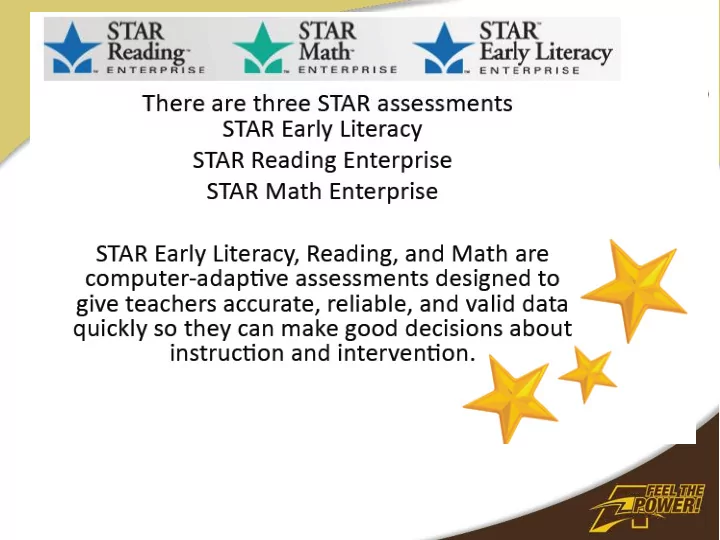

What is STAR testing
Purpose of STARS Universal screening Benchmark and establish baseline data Progress Monitoring (Watch the growth over time) Diagnostic Assessment Helps to design instruction for students at all levels
How often is it given? Benchmarking and Progress Monitoring Benchmark Test All students will be given the appropriate test for a grade level 4 times a year. Progress Monitoring Will be given to groups of student s who are below grade level Will be given as often as every 3 weeks, or once a month Used to help show if the intervention instruction is helping students to show growth
What Stars Assessments Look Like
STARS Early Literacy Audio: "There are four cars in a parking lot. One car leaves. Pick the number for how many cars are left." Audio: "Look at the pictures: hook, brick, road. Pick the picture whose ending sound is different from the others."
Scoring
Benchmark Categories
Screening Report
Student Individual Reports
Grouping Grouping allows teachers to differentiate instruction
Parent Report Math Scaled Score is the most useful information. Percentile rank is a norm- Normal Curve Decisions for instruction referenced score that Equivalent scores are based on the provides a measure of a range from 1 to 99 and student’s reading ability Scaled Score are mostly used for compared to other students research. in the same grade nationally. Percentile rank range indicates the statistical variability in a student’s Grade Equivalent is a percentile rank score. For example, norm-referenced score that a student with a percentile rank represents how a student’s range of 32 – 59 is likely to score test performance compares within that range if the STAR test is with other students taken again within a short time nationally.
Parent Report Reading Percentile rank is a norm- Instructional reading level is a criterion- referenced score that referenced score that indicates the highest provides a measure of a reading level at which a student is at least 80 student’s reading ability percent proficient at recognizing words and compared to other students understanding material with instructional in the same grade nationally. assistance. Zone of proximal development is a range of readability levels from which a Percentile rank range indicates the statistical variability in a student’s student should select books to read. It is a range that is neither too hard nor percentile rank score. For example, too easy, within which students can a student with a percentile rank range of 32 – 59 is likely to score experience optimal growth. within that range if the STAR test is taken again within a short time
Parent Report Early Literacy Transitional Reader Student has mastered Scaled Score is the alphabet skills and letter-sound relationships. most useful information. The student can identify many beginning and Decisions for instruction ending consonant sounds and long and short vowel sounds, and is probably able to blend are based on the sounds and word parts to read simple words. Scaled Score Emergent Reader Student is beginning to Probable Reader Student can identify understand that printed text has meaning. most of the letters of the alphabet and The student is learning that reading involves can match most of the letters to their printed words and sentences, and that print sounds. The student is also beginning flows from left to right and from the top to the to “read” picture books and familiar bottom of the page. The student is also words around the home. beginning to identify colors, shapes, numbers, and letters.
References • http://www.renlearn.com/sel/sample.aspx • http://avsd.k12.pa.us/site/dmd/STAR%20Assessment%20powerpoin t.pdf • http://www.renlearn.com/training/app/product.aspx?p=STAR
Recommend
More recommend